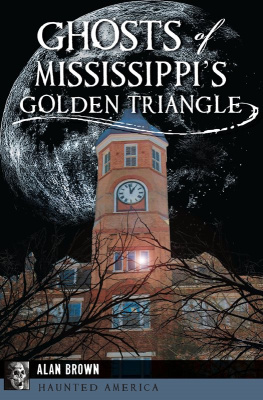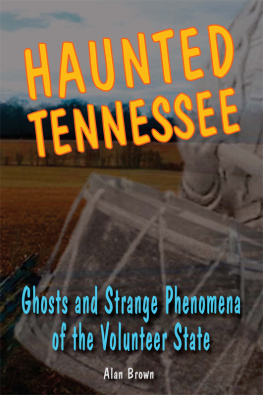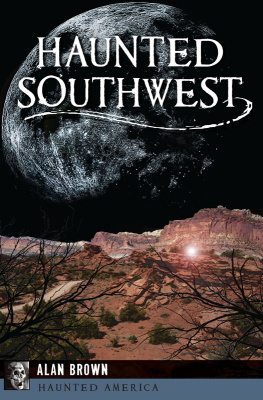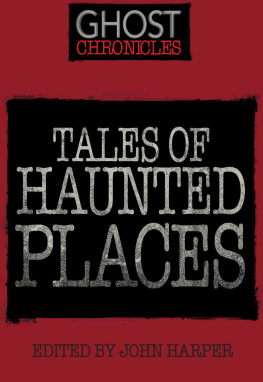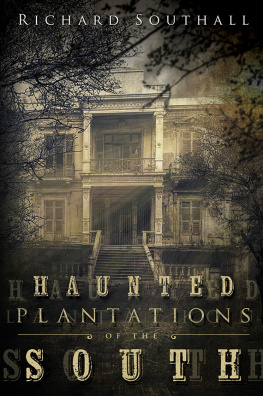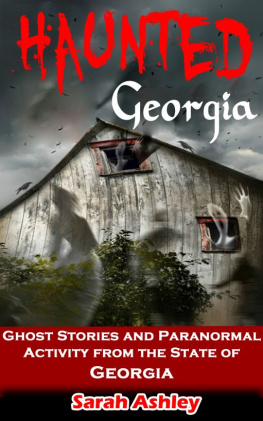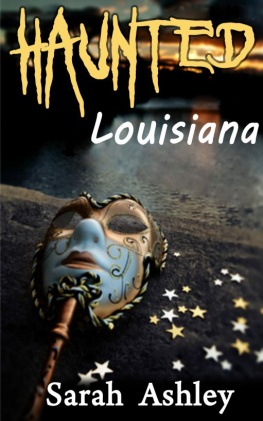HAUNTED PLACES IN THE AMERICAN SOUTH
HAUNTED PLACES IN THE AMERICAN SOUTH
Alan Brown

www.upress.state.ms.us
Copyright 2002 by University Press of Mississippi
All rights reserved
Manufactured in the United States of America
10 09 08 07 06 05 04 03 02 4 3 2 1
Library of Congress Cataloging-in-Publication Data
Brown, Alan, 1950 Jan. 12
Haunted places in the American South / Alan Brown.
p. cm.
Includes bibliographical references and index.
ISBN 1-57806-476-7 (cloth : alk. paper) ISBN 1-57806-477-5
(pbk. : alk. paper)
1. GhostsSouthern States. 2. ApparitionsSouthern States.
3. Haunted housesSouthern States. I. Title.
BF1472.U6 B743 2002
133.10975dc21
2002000635
British Library Cataloging-in-Publication Data available
To Marilyn, my sheltering spirit
CONTENTS
ACKNOWLEDGMENTS
I am deeply indebted to the following librarians who responded to my request for information: Trudy Bazemore from the Georgetown County Library System (Georgetown, South Carolina); Marianne Cawley from the Charleston County Public Library (Charleston, South Carolina); Don Paul Crook from the St. Mary Parish Library (Franklin, Louisiana); Glen Emery from the Jacksonville Main Library (Jacksonville, Florida); Laura Garcia from the Corpus Christi Public Library (Corpus Christi, Texas); L. Hatchet from the Texas Genealogy Department (San Antonio, Texas); Rita Holtz from the Alexandria Library (Alexandria, Virginia); Michael Maurin from the St.John the Baptist Parish Library (La Place, Louisiana); Donna Stephens from the St.Augustine Historical Society (St. Augustine, Florida); Beverly Tetterton from the New Hanover County Public Library (Wilmington, North Carolina); Fred G.Turner from the Olivia Raney Library (Raleigh, North Carolina); Cynthia Vise from the State Library of Florida (Tallahassee, Florida); and Doug Weiskopf from the Houston Public Library (Houston, Texas).
I would also like to thank Joyce Brannan, Pattie Grady, Scott Honeycutt, Ruth Jacob, Kenneth Reynolds, Christopher Shelton, and Troy Taylor, who served as consultants for this project. Finally I am grateful to the UWA University Research Grants Committee for providing me with funding for this project.
PREFACE
The idea for this book came about as a result of my interest in storytelling. After moving to Meridian, Mississippi, from Springfield, Illinois, in 1986, I discovered that one thing southerners love even more than football, bass fishing, and fried chicken is talking. Most southerners seem to be willing to take the time to tell tales and to listen to them as well. My first five books are, in fact, a celebration of southern storytelling. In all of my previous books, I adopted the folklorists approach to oral narratives and transcribed the stories exactly as I heard them. No matter what the informants were talking aboutoutlaws or sharecropping or ghoststheir individual voices came through.
After the publication of my last book of folkloreShadows and Cypress: Southern Ghost Stories (2000)I decided to look at ghost legends from an entirely different angle. Taking my cue from such established storytellers as Kathryn Tucker Windham and Nancy Roberts, I paraphrased many of the tales I received from informants and from published accounts. Although I did attempt, now and then, to add a few literary flourishes to my rewritten versions, I did not consciously add any fictional elements for the sake of drama or suspense. Most of the stories, I felt, were already so incredible that they did not need embellishment.
A project as ambitious as this one has turned out to be could not have been completed without the assistance of many other individuals. Dennis William Haucks Haunted Places: The NationalDirectory (1996) proved to be an indispensable tool as I set about collecting the stories for this book. All of my informants are listed in the bibliography. Most of these people (local historians, curators of historic homes, and others) were very familiar with the history and lore of the haunted places. I also relied very heavily on librarians from all over the South. All of these people graciously took the time to comb their vertical files for obscure clippings from newspapers and magazines. After completing my book, I had ample proof that southern hospitality is still alive and well.
INTRODUCTION
Have you ever wondered why so many ghosts seem to favor houses? I came to this conclusion in 1996 and again in 2000 when I completed two collections of oral ghost narratives. Of all the places given by my informants as settings for their tales, houses far outnumbered other locales. The reason for this is clear. Houses are places where human beings spend many of the most meaningful times of their lives. For generations, people were born in the home, and many have died there as well, sometimes under very tragic circumstances. For many people, the home is their entire world, the place that gives them their identity. It is small wonder, then, that in some cases, the home ties are so strong that they continue to be a powerful attraction, even after death. Not surprisingly, the majority of the haunted places mentioned in this book are houses.
By the same reasoning, though, any location that has been frequented by people has the potential of being haunted. The list includes other types of buildings, such as factories, libraries, and hotels. It can also include outdoor settings, such as forests, gorges, and railroad crossings. Even modes of transportation, such as steamboats, have been known to harbor spirits. In other words, ghosts can be found anyplace where people can be found.
Several criteria were used in selecting the places included in this book, other than the presence of ghosts at some point in their history. Like any collector of legends, I gave preference to those stories that have never been published before in book form. These stories include places such as Peavey Melody Music in Meridian, Mississippi; the Vander Lights in Vander, North Carolina; and the Governors Mansion in Austin, Texas. I was also interested in updating stories that are much better known, such as Waverley in West Point, Mississippi, and the Myrtles in St. Francisville, Louisiana. Most, but not all, of the places featured in this book are open to the public. I selected private residences for inclusion in the book only if the stories were too good to pass up. All of the buildings except for two are still in existence.
Most of the stories in Haunted Places in the American South are legends, meaning that they are tales based in fact but which have been embellished over the years through various retellings. Most of these stories are very old, reflecting the history of the places they describe. The longest, and often the best, stories are those told by people who have had actual brushes with the supernatural. From the standpoint of the folklorists, first-hand accounts are not legends until they have been told to someone else, who then passes the story on with his own little touches. A few of the stories in this book, such as Headless Woman Rock in Leitchfield, Kentucky, and the Ell Davis Woods near Eudora, Mississippi, are so fanciful that they almost qualify as folk tales, stories that both the storyteller and the audience recognize as being fictional. I kept the number of folk tales to a bare minimum because most people seem to favor those tales that call for a position of belief or disbelief. We seem to be drawn to stories that make us question our view of reality, of what could happen under the right circumstances.
Next page

